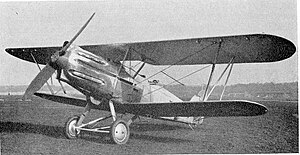Hawker Hector
| Hawker Hector | |
|---|---|
| Type: | Close air support |
| Design country: | |
| Manufacturer: | |
| First flight: |
February 14, 1936 |
| Number of pieces: |
179 |
The Hawker Hector was a further development of the successful Hawker Audax from the Hart family . It is a two-seat, single-engine biplane that was originally intended only as an improved Audax in the role of army support.
development
The aircraft was powered by the Napier Dagger IIIMS with 805 hp. The Audax was used as the fuselage, while the upper wing had to be replaced by a modified one due to the higher performance. In addition, a rear wheel was installed. The prototype K3719 flew for the first time on February 14, 1936. All 178 series machines were built by Westland in Yeovil and delivered to the RAF in 1937 .
commitment
In addition to six army support squadrons, five squadrons of the Auxiliary Air Force were also equipped. In 1940 the Hectors were withdrawn from active squadrons and assigned to training units. After cargo glider units had been set up, the Hector was used by the 296th Squadron to pull the hotspur gliders. In late 1942, the Hectors were assigned to the Glider Training Schools and retired in 1943.
Technical specifications
| Parameter | Data |
|---|---|
| crew | 2 |
| length | 9.09 m |
| span | 11.26 m |
| Wing area | 32.14 m² |
| height | 3.17 m |
| Empty mass | 1537 kg |
| Max. Takeoff mass | 2227 kg |
| drive | a Napier Dagger III MS with 600 kW (805 PS) |
| Top speed | 301 km / h at an altitude of 1980 m |
| Flight duration | 2.25 h |
| Service ceiling | 7315 m |
| Armament | 1 × fixed 7.7 mm machine gun, 1 × moving 7.7 mm Lewis machine gun , 2 × 51 kg bombs under the wings |
literature
- James J. Halley: The K File. The Royal Air Force of the 1930s , Tunbridge Wells, 1995, p. 242 ff.
- Aero. The illustrated compilation of aviation, issue 149, p. 2568
Web links
Individual evidence
- ↑ Peter Alles-Fernandez (Ed.): Aircraft from A to Z. Volume 2. Bernard & Graefe, Koblenz 1988, ISBN 3-7637-5905-0 , p. 355
